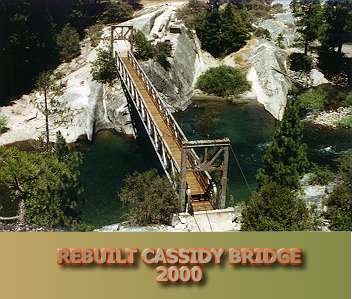Cassidy Suspension Bridge, 1997 & 2000
Ansel Adams Wilderness, Minarets Ranger District, Sierra National Forest, CA

Satellite view of bridge. View Larger Map
|
Cassidy Suspension Bridge, 1997 & 2000 Ansel Adams Wilderness, Minarets Ranger District, Sierra National Forest, CA
|
Satellite view of bridge. View Larger Map |
USE: Pack & Saddle Stock/Pedestrian
SPAN: 150'
TRAVEL WIDTH: 5'
TOWERS: A7 Steel Box Beam
ANCHORS: 1 1/2" grouted in place loop rock anchors
MAINLINES: 1-1/2" Bridge Strand

The Cassidy Suspension Bridge crosses the middle fork of the San Joaquin River, deep in the heart of the Ansel Adams Wilderness, south of Yosemite National Park. This bridge is a classic example of a stiffened suspension bridge and has a long and fascinating history: Originally built by the Work Projects Administration as a 300' vehicle bridge in 1933, near Happy Camp in Northern California, it was disassembled, shortened to 150', and relocated in the mid-1950s to its present remote location. In the winter of 1996-97, the bridge was severely damaged in a catastrophic flood, nearly collapsing into the San Joaquin River. The photo you see above shows the bent Warren truss and broken upriver suspenders resulting from the flood. Sahale was initially called upon by the U.S. Forest Service to stabilize the damaged bridge and later developed an engineering upgrade, completely rebuilding the bridge mainspan.
Stabilizing the bridge involved installation of temporary suspenders, field straightening and leveling of the truss, and returning the truss back to its original bearing location so that it could be used on an interim basis for traffic. Subsequent to the stabilization work, Sahale engineered a complete rebuild of the bridge to replace damaged parts and upgrade the superstructure. The field work was completed by Sahale in late spring/early summer, 2000, and involved the installation of new suspenders and redesigned floor beams, replacement of damaged truss members, installation of new style slip joint bearing sills, upgrade of the diagonal bracing system, and replacement of timber deck and railing components.
Mobilization to this remote site was accomplished using pack stock for the stabilization phase, and helicopter for the main span rebuild in 2000. Altogether, more than 40,000 pounds of steel, timber, tools and camp equipment was mobilized by air for the bridge reconstruction. Heavy early season snows and high river runoff isolated the site, with the crew spending six weeks on location before the first visitors were able to make it in to Cassidy Bridge.